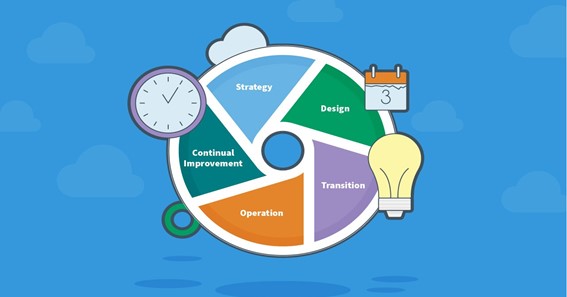Industry competition is getting severe. Every company strives hard to generate better business and stay ahead in the race. The best thing that a business can do to edge other ventures is to align with IT and optimize its use in all processes. However, it’s no less than a challenge. Enterprises face immense obstacles en route to maximized IT utility across all departments and operations. How to do so?
That is understandable; such a goal is unachievable without putting firm frameworks in the foreground. A business must harness a few guidelines to ensure maximum utilization of IT services and make the processes highly efficient. Right here, ITIL steps forward! It has become the most adopted framework across industries that relies on IT services.
In this article, you will get to dive deeper into advanced ITIL aspects. We will discuss various ITIL processes and the best practices to bring the best out of the frameworks for an enterprise.
Let’s step beyond the simple ITIL course that deals with fundamental concepts and understand the framework’s subtle aspects.
ITIL Frameworks: Key Pillars
Since their inception, the modern ITIL frameworks have undergone several transitions, updates, and revisions. However, three essential pillars remain the same throughout all versions of the ITIL guidelines.
You must understand these pillars before understanding the advanced ITIL concepts. Believe it or not, these aspects will make the best practices more relatable for you.
Click here – Texas medical students wrongly accused in the Title IX cases – Reasons and solution
So, here’s a quick glimpse of the ITIL pillars mentioned below:
- Change Management
Changes in a company’s IT posture bring numerous risks. Despite such threats, you cannot overlook IT adoption as it is essential for its sustainability. So, the first critical ITIL pillar is Change Management. It allows achieving process speed and best outcomes while avoiding risks and aftereffects.
- Incident Management
You might have invested in cutting-edge IT services and generated the best outcomes from them. But, several incidents might halt your smooth processes. For instance, a business might encounter sudden server glitches that stop all operations in one shot. Managing such unplanned scenarios comes under Incident Management – another essential ITIL principle.
- Problem Management
Although incidents and problems seem the same, they differ in several aspects. Repetitive incidents cause issues. For example, the above laptop might show recurring hard disk issues even after several replacements. It’s a case of an IT problem. As you can see, repetitive laptop incidents cause issues. The final ITIL pillar solves problems and offers practical strategies to deal with such problems.
The above three pillars support entire ITIL frameworks. Every ITIL process and the best practices keep these critical objectives in the foreground.
Now that you have a clear understanding of the three essential ITIL pillars, it’s time to move on to the advanced aspects of the guidelines.
Keep reading!
Essential ITIL Processes
IT services are essential for your business. However, managing them can be a Herculean task. Do you know? Ensuring cooperation and optimized utility of all services across the IT lifecycle is a massive challenge. Luckily, ITIL processes offer a better avenue of managing synchronization among all IT services.
Ideally, ITIL processes have five stages, each committed to bringing seamless cooperation among all IT services in the entire lifecycle. Let’s discuss the various stages and understand ITIL processes in somewhat detail.
Stage 1: Service Strategy
The best side of IT services comes up when a company lays optimum strategies in the foreground. It begins with identifying the best goals and requirements in a corporate environment. It is the first process stage in the ITIL lifecycle called service strategy.
Stage 2: Service Design
As the name suggests, service design aims at creating the blueprints for management processes, IT services adoption, and other functions. It acts as a crucial phase in the business environment.
Stage 3: Service Transition
Transition encompasses several disruptions and challenges. So, ensuring a seamless transition is essential for the healthy functioning of a business. This stage prioritizes developing transition strategies for the healthy functioning of existing operations.
Stage 4: Service Operation
The service operation stage aims at turning down day-to-day operations to monitor and control the existing infrastructure. Businesses need to cater to customer and staff requirements through consistent IT services.
Stage 5: Continual Service Improvement
Maintaining the quality of IT services is essential to produce improved outcomes. So, the last phase aims at continual service improvement in an IT-driven environment.
These stages of ITIL processes are essential to achieve all your goals from IT services. A business can harness all purposes and address customer demands by aligning with the above processes from the beginning.
Now, you are all set to understand a few best practices in the ITIL domain. Let’s dive in!
Some ITIL Best Practices
ITIL best practices will take you towards massive success as ITIL professionals. So, let’s get a glimpse of such measures right below!
- Remember that a better experience is the ultimate purpose of harnessing IT services. So, collecting data from various levels to find areas of improvement is the first best practice.
- The ITIL best practices suggest identifying threats in the corporate workflow and solving them on time before they convert into massive issues.
- Consider grouping similar-looking incidents in the business workflow. It will allow bringing better solutions for most concerns in one shot.
- Every problem requires optimum solutions. But, solutions cannot become efficient until you keep improving them from time to time. So, you must find the best solutions as an ITIL manager in the company.
- Bring automation wherever possible! Automation can help you push the business towards massive success without burdening your employees. It is one of the IT objectives in most organizations. So, you should identify scopes of automation in the enterprise and plan to reduce manual processes optimally.
You are a step ahead in the ITIL journey with the above knowledge. As top-notch ITIL professionals, you should keep these best practices in mind. Believe it or not, these guidelines will help you get the best out of IT services for the company quickly.
Click here – 5 Legit ways to make money online with Google



